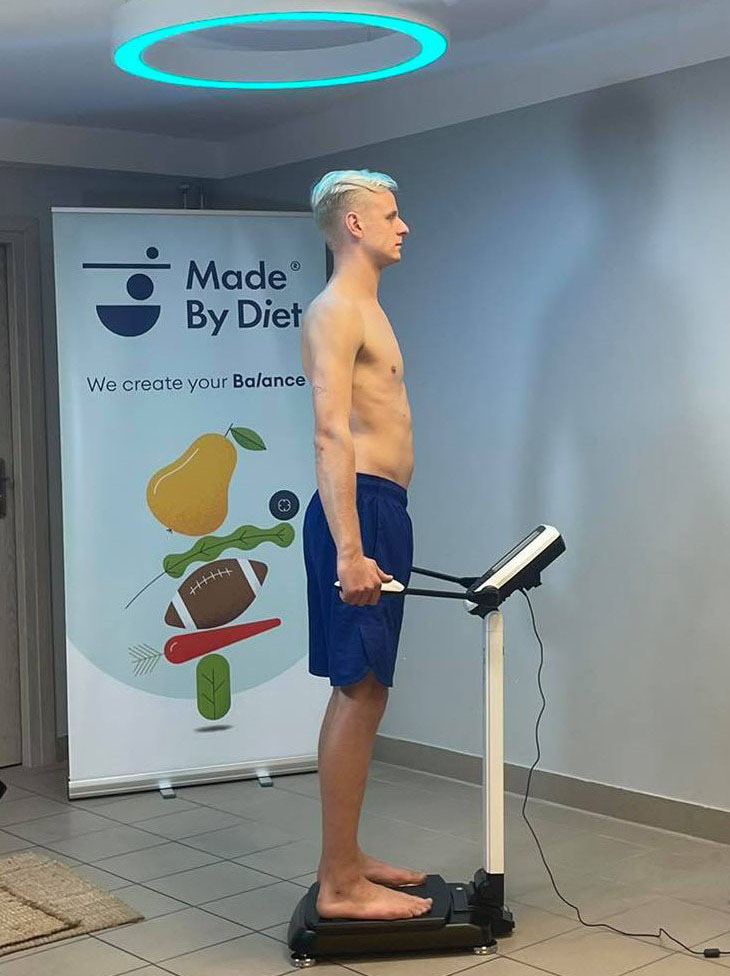Prepare yourself for the body composition analysis
At Made By Diet®, we perform the body composition analysis in the form of the Bioelectric Impedance Analysis (BIA) method using InBody professional analyser (the measuring accuracy is approx. 98%). The assessment takes less than 60 seconds, enabling the determination of fat and muscle mass and percentage share, together with segmental analysis. Due to the specific nature of this measurement method, it is worth preparing oneself for the assessment, so that the results are reliable and repeatable.
Below you can find some pieces of advice:
- You should have the measurement performed before any physical activity, e.g. workout, planned on that day.
- Bring light clothes (preferably sports shorts and T-shirt) with you.
- You should eat you last meal 3 hours before the assessment.
- Use the toilet before the assessment.
- Avoid taking shower directly before the measurement.
- Before stepping on the analyser, remove all metal objects, e.g. belt, jewellery, shirt with metal buttons, etc.
There are several absolute contraindications against the performance of the body composition analysis. They are very rare, but we must inform you about them. These are:
- pacemaker,
- “Ability” type electrical devices in your abdomen,
- metal implants in the body (this does not apply to cochlear implants or the insulin pump),
- pregnancy,
- epilepsy.
However, a person with dental braces, teeth implants, a cochlear implant, an insulin pump, as well as bone fixing screws and plates can have the assessment performed.
What is bioelectrical impedance? What is body composition analysis using the BIA method?
Bioelectrical impedance analysis (BIA) is a method of assessing body composition that uses differences in the electrical conductivity of individual body tissues (such as muscles, fat and bones). These differences are used to determine the share of individual tissues in the total body weight. This way we find out the percentage of fat or muscle in the body.
The BIA method is based on the fact that tissues containing a lot of water and electrolytes (e.g. muscles) conduct electricity better than tissues containing less water (e.g. adipose tissue). Body composition analysis using the BIA method involves passing an alternating electric current of low and completely safe voltage and amperage through the body and measuring the differences in its flow. By measuring the resistance (impedance) of individual tissues to electric current of a specific frequency, we can estimate their proportions in the body
What are the advantages of the InBody analyser? Can their results be trusted?
InBody body composition analysers are considered one of the most advanced and accurate devices using the bioelectrical impedance analysis (BIA) method. When we decide to analyse body composition using BIA, we can count on:
- high accuracy and repeatability of measurements;
- segmental body composition analysis (InBody devices provide detailed information about the composition of individual body parts, e.g. arms, legs, torso);
- no need to use empirical estimating equations (InBody analysers directly measure impedance, which contributes to greater accuracy);
- ease of use and speed of measurement;
- detailed reports and progress monitoring.
InBody analysers are particularly convenient for conducting relative comparisons (monitoring changes in the body composition of one and the same person over a longer period of time). These devices are used in many professional institutions, including medical centres, fitness centres, dietitians, doctors and health specialists.
InBody BIA body composition analysers are valued for their accuracy and advanced technology, but like any measurement method, they may have some limitations. That is why the results obtained with them should be interpreted with some caution, in the context of a broader assessment of health and physical condition, and therefore with the participation of a specialist familiar with the matter.
What can influence the results?
It is important to remain calm and stand still during the test, as your movements may disrupt the flow of electricity and affect the results. If you plan a regular BIA body composition analysis, try to always perform it at the same time of day and in similar conditions so that the results obtained are comparable.
And what factors may adversely affect the accuracy of BIA analysis results? These may include dehydration, excessive hydration, undigested food in the digestive tract, altered fluid distribution in the body as a result of intense physical exercise, and increased water retention during menstruation.

 PL (PLN)
PL (PLN) EN (GBP)
EN (GBP) EN (EUR)
EN (EUR)